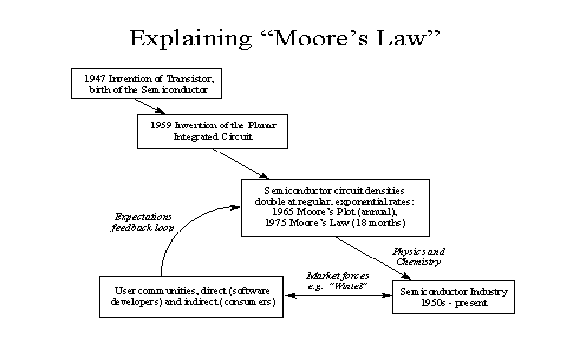Moore's Law
(2025-09-23T20:29.905Z)
Perplexity Query
(2025-09-23T20:29
.905Z)
Question:
Write a comprehensive one-page article about "Moore's Law".
Model: sonar-pro
Moore’s Law: The Engine Behind a Digital World
Moore’s Law is the observation that the number of transistors on a microchip doubles approximately every two years, leading to exponential growth in computing power and efficiency.
[jllse7]
[1bqevv]
[yr8egd]
This guiding principle, first described by Intel co-founder Gordon Moore in 1965, has propelled the semiconductor industry for decades and shaped the evolution of modern technology.
[jllse7]
[8zj92k]
Understanding Moore’s Law is essential for appreciating the rapid pace of digital innovation, from personal computers to artificial intelligence.

The Concept and Its Impact
At its core, Moore’s Law is an empirical observation rather than a physical law: it predicts that integrated circuits' transistor count will double at regular intervals, generally every two years.
[jllse7]
[8zj92k]
As a result, each successive generation of chips offers more power at a lower cost and in a smaller footprint. This trend sparked a "self-fulfilling prophecy" where companies aligned research, development, and manufacturing schedules to keep pace with Moore’s Law, ensuring sustained growth throughout the electronics sector.
[1bqevv]
[yr8egd]
The most tangible benefit has been the massive increase in computing power. Early microchips in the 1960s contained dozens of transistors; today, chips often contain tens of billions.
[8zj92k]
This exponential scaling enabled the rise of affordable personal computers, smartphones, cloud computing, and sophisticated devices like medical scanners and autonomous vehicles.
[8zj92k]
[yr8egd]
Practical Examples and Use Cases
- Cloud computing and data centers: High-density, powerful chips made large-scale internet services scalable and affordable, fueling the growth of platforms like Google, Facebook, and Amazon. [8zj92k]
- Healthcare and science: Improved microprocessors make real-time medical imaging and high-throughput genetic sequencing possible, accelerating diagnostics and research.
Benefits and Applications
Moore’s Law has consistently delivered:
- Lower costs for higher performance, democratizing access to technology and nurturing entire digital economies.
- Compact, energy-efficient devices, making everything from smartwatches to IoT sensors possible.
- Faster, more powerful tools for scientific research, industry, and entertainment.
Challenges and Limitations
In recent years, maintaining Moore’s Law’s pace has become increasingly challenging as transistors approach atomic sizes.
[7jr00t]
[1bqevv]
[yr8egd]
Physical limits, escalating costs of fabrication, and issues like heat dissipation make further scaling difficult. The industry has responded with innovations in materials, chip architectures (e.g., 3D stacking, FinFETs), and manufacturing methods (e.g., extreme ultraviolet lithography), but conventional scaling is slowing.
[7jr00t]
[yr8egd]

Current State and Trends
Today, Moore’s Law’s exponential curve is flattening—the doubling of transistor counts now takes longer, and improvements come at greater cost and complexity.
[1bqevv]
[yr8egd]
While top manufacturers like Intel, TSMC, and Samsung continue to push towards denser nodes (such as 5nm and 3nm technologies), industry consensus acknowledges that traditional scaling cannot be sustained indefinitely.
[1bqevv]
Key trends include:
- Shifting focus from pure transistor density to system-level performance, energy efficiency, and integration.
- Adoption of advanced manufacturing methods like extreme ultraviolet (EUV) lithography and heterogeneous integration. [yr8egd]
- Increased investment in alternative computing paradigms, such as quantum computing and neuromorphic architectures.
Recent years have seen startups and incumbents alike exploring new directions, such as AI-specific accelerators, photonic chips, and advanced packaging to maintain overall progress in computing.

Future Outlook
Looking ahead, while the original vision of Moore’s Law is approaching its physical limits, the industry is pursuing "More than Moore" innovations—combining new materials, chiplet designs, and alternative computation models to extend progress. Future computing will likely blend classical advancements with breakthroughs in fields like AI-specific devices and quantum processors, continuing to unlock new applications across sectors.
[7jr00t]
[8zj92k]
Conclusion
Moore’s Law revolutionized technology, enabling the exponential digital growth that underpins modern life. As its original trajectory slows, the drive for innovation persists, ensuring that the spirit of Moore’s Law will continue to shape the future of computing in transformative ways.
[7jr00t]
[8zj92k]
Citations
[jllse7] 2025, Sep 23. How Does Moore's Law Work? - Synopsys. Published: 2025-09-09 | Updated: 2025-09-23
[7jr00t] 2025, Sep 23. What's Moore's Law? Its Impact in 2025 - Splunk. Published: 2024-11-22 | Updated: 2025-09-23
[1bqevv] 2025, Sep 23. Moore's law - Wikipedia. Published: 2001-09-27 | Updated: 2025-09-23
[8zj92k] 2025, Sep 23. Moore's Law | ASML - Supplying the semiconductor industry. Published: 2023-08-22 | Updated: 2025-09-23
[yr8egd] 2025, Sep 23. What is Moore's Law? - Microchip USA. Published: 2024-12-18 | Updated: 2025-09-23
[6]: 2025, Sep 23. Moore's Law: The Beginnings - ECS - The Electrochemical Society. Published: 2023-05-12 | Updated: 2025-09-23
[7]: 2025, Sep 23. Moore's Law and Its Practical Implications - CSIS. Published: 2022-10-18 | Updated: 2025-09-23